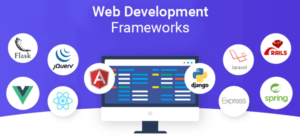When developers start working on a digital product, they don't write its code from scratch. Instead, they resort to frameworks. In this article, experts from Promodex Agency will explain what a framework is and what are the benefits of using it. We'll talk about the difference between the two types of frameworks and share the brief characteristics of the five most popular solutions.
What Is A Web Development Framework?
A web framework is a software platform for building digital products. It can be used for creating websites, web APIs and other types of web resources. It features a selection of ready-to-use components that can be easily combined with each other. For instance, you can find app templates and code snippets in a framework. All these elements are standardized.
Benefits Of Using Web Development Frameworks
Frameworks enable developers to achieve the following goals:
- Facilitate and accelerate the development process. Professionals pick the most opportune components and fine-tune them so that they meet the product's needs.
- Optimize code. Gone are the days when programmers had to write long lines of code. Now, developers get access to concise snippets that enhance the product's functionality.
- Simplify debugging and maintenance. There is an active community around each framework. Whenever you need a consultation, colleagues will be eager to help you out.
- Enhance security. Frameworks contain a lot of in-built features that prevent threats.
The main disadvantage of frameworks consists in the fact that none of them is perfect. Each solution has its pros and cons. You should opt for the one that best meets the requirements of the product that you're working on.
Difference Between Front-End Frameworks and Back-End Frameworks
Front-end frameworks are alternatively known as client-side ones. Their back-end counterparts are also called server-side ones. The former are used to create that layer of the digital product that end-users interact with. The latter are needed to build the "invisible" layer of the website that ensures its functionality.
Client-side frameworks are responsible, in particular, for scalability, SEO optimization and UI/UX. Server-side solutions are in charge of such aspects as the website's architecture, URL routing and security.
React.js
Technically speaking, it's a code library and not a full-fledged framework. Nevertheless, it's highly functional and extremely popular. It's used to create JS interfaces. It is compatible with multiple programming languages and tech stacks.
This solution has in-built tools that facilitate SEO.
React.js promptly transforms HTML-based code into the layout of a web page. As soon as you modify the code, the interface will be updated. If you need to deliver a mobile app, resort to React Native.
On the flip side, you should be ready to install various code collections and other complementary components to expand the default functionality of React. Plus, its documentation often seems confusing to novice users.
Angular
This one is not suitable for the mobile format. Besides, it is HTML-centered which makes model-view-controller patterns a bit too complicated.
Apart from these two drawbacks, Angular has so many advantages that it has become the most popular full-fledged framework. It's an open-source solution with a continuously expanding range of free plugins and instruments. It's compatible with all the most popular browsers and is recommended for products with complex functionality.
Angular is a spot-on choice for Rich Internet Applications. They give you access to desktop functionality right on your browser.
Vue.js
It is used for creating the client-side part. Vue is flexible and renowned for its high speed. Its default functionality can be characterized as basic — but you can extend it with APIs, add-ons and libraries.
This solution enables you to edit templates and styles in a separate file. When you decide to scale the product, it will be easy for you to transfer data from one codebase to another. The documentation is very clear.
When using Vue.js, you should be ready to cope with two disadvantages. First, its community is smaller, compared to other frameworks. Second, it has a steep learning curve. Even if you're experienced in JS, your previous expertise will hardly come in handy.
Node.js
This open-source solution is compatible with multiple operating systems. It works equally well for the back-end and front-end parts. The primary advantage of Node is its fast performance. However, its modules are often redundant, which means you'll have to invest more time in coding. The reason for this drawback is that originally, JavaScript was meant to be used for building the front-end part. Then, it was artificially modified to be able to cope with the server-side layer.
Node.js is not the best option for dealing with CPU-intensive tasks. It can complete only a limited number of such tasks at a time.
Ember.js
This framework can boast of exceptionally rich functionality. It features a huge library. Developers appreciate the opportunity to rely on Handlebars for navigation. Requests are processed very quickly thanks to a live reload.
Ember is a relatively young open-source solution but it has amassed a large and active community.
As for the shortcomings, this framework tends to be slower than the others mentioned in this article. To compensate for this, you can resort to add-ons. Besides, novice developers often struggle to get used to its component structure.
Final Thoughts
Developers use frameworks to optimize code, accelerate the development process, enhance security and simplify maintenance. There are separate frameworks for the front-end and the back-end parts of the digital product. The most popular solutions are React.js, Angular, Vue.js, Node.js and Ember.js.



